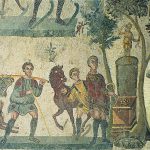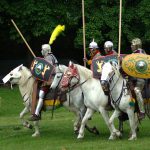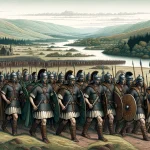Ebchester (Vindomora) Roman Fort
Flavian Auxiliary Fort (AD 69–96)
The site of Vindomora Roman fort at Ebchester. Excavations have exposed the remains of a Roman fort of two phases dating from AD 69 to AD 117, and from circa AD 150 to the end of the 4th century. The possible site of the vicus is also recorded. Much of the site has been destroyed by modern development.
The Ebchester Fort
RIB 1106 - Building inscription of the fifth cohort
The fifth cohort (built this).
Huebner (addit. p. 309) says that his note to 460 is a mistaken duplication of the note to 461.
RIB 1109 - Centurial stone of Martialis
From the fifth cohort the century of Martialis (built this).
[.] MARTIAL
No commentary.
RIB 1113 - Building inscription of the Fourth Cohort of Breuci
The Fourth Cohort of Breuci ..
For coh. IIII Breucorum at Ebchester see RIB 1101. Addenda from RIB+add. (1995): See RIB 2385* for an erroneous reading.
The Garrison of Vindomora
Cohors Quintae Legionis?
Although it is possible that the first occupants of the Ebchester fort were indeed the Fifth Cohort of an unidentified Roman legion (vide supra), they are only identified on building inscriptions and centurial stones, which cannot be taken as evidence of occupation because all Roman auxiliary forts were actually built by the highly-trained legionaries, and not entrusted to the peregrine auxiliary soldiers who were to garrison the completed camp. Without the evidence even of a single altarstone, we must conclude that the Fifth Cohort were only at Ebchester to build the fort, not to inhabit it.
RIB 1101 - Dedication to Minerva
To the holy goddess Minerva Julius Gr[…]nus, actarius of the Fourth Cohort of Br[euci], styled Antoniniana, gladly, willingly, and deservedly fulfilled his vow.
VAE IVL GR[4]
NVS ACTAR[...]
COH IIII BR[...]
ANTONINIAN[ ...]
L L M
A.D. 213-22, as the unit is styled Antoniniana.Wrongly ascribed by Horsley to Carvoran.For an actarius see RIB 429, and Glossary.
The first attested garrison unit at Ebchester is Cohors IV Breucorum, identified from the early-third century altar to Minerva the Roman war goddess shown above, and also on an undated but probably contemporary building inscription (vide RIB 1113 supra). They were a five-hundred strong infantry regiment originally levied from amongst the Breuci tribe of Pannonia Inferior, natives of the Bosna valley in north-eastern Bosnia-Herzegovina.
This unit may be associated with the Cohors Quartae F[…]? attested at Lavatris (Bowes, Durham; RIB 739) on a dedicatory inscription dated 130-3AD.
RIB 1100 - Altar dedicated to Mars and to the Divinity of our Emperor
To the god Mars and to the Divinity of our Emperor, Pius and Felix.
AR[...]E ET N
AVG N P F
The emperor is indeterminable as Commodus and most subsequent emperors used Pius, Felix in their style.
The Roman Gods of Vindomora
RIB 1102 - Altar dedicated to Vernostonus Cocidius
To the god Vernostonus Cocidius, Virilis, a German, willingly fulfilled his vow.
VERNO
STONO
COCIDI
O VIRI[...]IS
GER V S L ❦
Lingard, quoted by Bruce, wrongly ascribed it to Flass, at the point where Dere Street crosses the Deerness. Huebner classed it as spurious but suggested that it might be a genuine altar recut, while Haverfield was not inclined to regard it as genuine.Some of the letters have been touched up, de in l. 1, ver in l. 2, st in l. 3, and c in l. 4. This will account for Hodgson’s vague report of this as a modern copy of an altar and for the doubts entertained by Huebner and Haverfield R.P.W.
Over the years, Ebchester has revealed a small number of altars which are dedicated to a mixture of classical Roman and Germanic/iron-age gods typical of an Auxiliary fort. There are two altars naming the ancient Germanic ancestor-god Vitiris, and single altars dedicated to the Genius or ‘local’ god, to the Roman war deities Mars and Minerva – on separate stones – and one also to Vernostonus Cocidius, an apparent conflation of two Germanic war gods.
RIB 1103 - Altar dedicated to Vitiris
To the god Vitiris Maximus fulfilled his vow.
VITIRI
MAXIMV
S V S
No commentary.
RIB 1099 - Altar dedicated to the Genius
To the Genius … Aurelius …, prefect, willingly fulfilled his vow.
[...] IV
A[...]RELIVS
[...]
[...]R[...]EF V L S
No commentary.
Classical References for Vindomora
References for Vindomora
- Historical Map and Guide – Roman Britain by the Ordnance Survey (3rd, 4th & 5th eds., 1956, 1994 & 2001);
- The Roman Inscriptions of Britain by R.G. Collingwood and R.P. Wright (Oxford 1965);
Roman Roads near Vindomora
Dere Street: NW (9) to Corstopitvm (Corbridge, Northumberland) Dere Street: SE (6) to Lanchester (Lanchester, Durham) Possible Military Road: NE (8) to Washing Wells (Whickham, Tyne & Wear)
Sites near Ebchester (Vindomora) Roman Fort
- Lanchester Roman Aqueduct (8 km)
Aqueduct - Lanchester (Longovicium) Fort (10 km)
Auxiliary Fort and Milestone - Lanchester (Longovicium) Vicus (11 km)
Vicus - Hadrian's Wall - Milecastle 12 - Heddon (12 km)
Hadrian's Wall Milecastle - Hadrian's Wall - Milecastle 13 - Rudchester Burn (12 km)
Hadrian's Wall Milecastle - Hadrian's Wall - Fort - Vindobala (12 km)
Hadrian's Wall Fort, Minor Settlement and Temple Or Shrine - Hadrian's Wall - Milecastle 14 - March Burn (12 km)
Hadrian's Wall Milecastle - Hadrian's Wall - Milecastle 11 - Throckley Bank Top (12 km)
Hadrian's Wall Milecastle - Hadrian's Wall - Milecastle 15 - Whitchester (12 km)
Hadrian's Wall Milecastle - Washingwells Roman Fort (12 km)
Stanegate Fort








